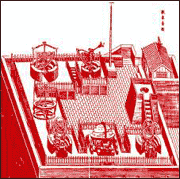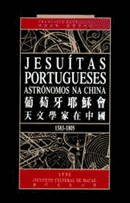|
The Mandarin astronomers
The Jesuit missionaries departed for China in the sixteenth century, where they proved to be of invaluable assistance in the development of astronomical science in eastern civilisation
 |
|
|
|
”IN THE HISTORY of the coming together of civilisations”, writes Joseph Needham in his monumental “Science and Civilization in China”, nothing seems to compare with the arrival in China in the seventeenth century of a group of Europeans so inspired by religious fervour as the Jesuits and, at the same time, so versed in the sciences that developed with the Renaissance and the rise of capitalism”.
Heading these European missionaries, many of which were Portuguese, was Matteo Ricci (1552-1610), a Jesuit of Italian origin, born of a rich family in Macerata, in the centre of Italy. Ricci was a disciple of Christopher Clavius (1538-1612), responsible for the reform of the modern calendar and the most important mathematician and astronomer of his day.
São Francisco Xavier had died in 1552 on the small island of Sanchoão, off the Chinese coast, in the sight of the big country he so wished to evangelise. When Ricci reached the East in 1582, after a long journey which started in Lisbon on board one of the caravels that departed from this city every year, China was still closed to foreigners. The missionaries stopped at Macao’s supply station and started studying the local language and customs, making contacts with the noble and intellectual Chinese. In the following year, Ricci was authorised to settle in the province of Quangtung. In 1589, he befriended several of Confucius’ scholars, teaching them mathematics, astronomy and geography. In January 1601, he managed to establish himself in Peking, where he published several books in Chinese, namely the Seis Primeiros Livros de Euclides. Following in Ricci’s footprints, many Jesuit missionaries came to Peking and made the acquaintance of Chinese academics, who respected them for their knowledge of astronomy, geography, cartography and mathematics.
The secret of the success of these missionaries, who managed to persuade the emperor of China to promulgate a decree of religious freedom in 1692, lies in their attitude of respect for the local customs – they dressed and behaved like Chinese, studied the doctrine of Confucius and knew the literature and philosophy of the East. However, the influence they came to have in the emperor’s court and in China is mostly due to their erudition and knowledge of the sciences, namely of astronomy.
”The Jesuits had observed the incapacity of the Chinese to correctly predict the occurrence of eclipses, as well as their incapacity to resolve the relationship between the solar and lunar calendars”, as Russel-Wood describes in his book “A World on the Move. The Portuguese in Africa, Asia and America, 1414-1808”. Understanding the importance that this problem had for the Chinese society, Ricci wrote insistently to Rome, pressuring Galileo and other astronomers for their help. “We are certain that mathematics will open the way for us”, wrote father Longobardo in a desperate request to Rome. “Send us mathematicians”. On another occasion, father João Rodrigues wrote from Canton: “Send us a large amount of mathematical books!”
|
 |
|
|
The pleas for help of Ricci and the missionaries were heard and several European mathematicians and astronomers travelled to China. They established themselves in Peking, penetrating the Forbidden City and socialising with the mandarins and dignitaries of the emperor’s court. Ricci became known as “Hsi-ju”, “The wise man of the West”.
Western astronomy was more advanced than Chinese astronomy and achieved practical results, which the Orientals were unable to accomplish, namely in forecasting eclipses. The Westerners played an important role in the reform of the Chinese calendar, which was based on lunar cycles and which had progressively moved away from the cycles of the annual seasons. The calendar was decisive for the empire, as can be expected, as it is a basic instrument of uniformity of civilian life, tax collecting, organisation of harvests, etc.
However, western astronomy had more errors than Chinese astronomy in several important cosmological aspects. It is curious that Ricci, on listing what he considered to be “absurdities” of the Chinese cosmology, should mention that for them (the Chinese) “there is only one sky (and not ten skies). It is empty (and not solid). The stars move in a vacuum (instead of being fixed in the firmament)”. Another “absurdity” listed by Ricci was that “they do not know that there is air (between the celestial spheres) and claim that there is an emptiness”.
As is known, Ptolemaic and Aristotelian cosmology of that time admitted that the celestial bodies moved in crystalline spheres, as Camões so well describes in Os Lusíadas. The stars were fixed in the sphere of the Firmament. “Under this vast Firmament”, wrote the poet, “you can see the sky of Saturn, old God”, and under it were the spheres of other planets, of the Sun and of the Moon. We know today, however, that the Chinese were closer to the truth. The stars are not set in a sphere but exist in interstellar space. There are no crystalline spheres in which the celestial bodies move. There is no air in-between the Earth, the planets and the stars.
In astronomical observation, the Chinese were also more advanced that the westerners. For many a century they had systematically observed the skies, making a note of the most important celestial phenomena, and had detected explosions of stars, namely the explosion in supernova recorded in 1054 and which today reveals its remains in the nebula of Cancer. Westerners, convinced of the immutability of the skies, one of the fundamental dogmas of Aristotelian and Christian cosmology, ridiculed such discoveries. The French author De Fontenelle, for example, ironised in 1686 that “it is boring that these spectacles (meteors and supernovas) should be reserved for China and not be seen in our countries…” What happened, in fact, was that westerners’ beliefs prevented them from believing in the changes in the sky. For a long time Europe had been asleep and had its back turned to observation and experience.
The Chinese, however, maintained a systematic observation of celestial phenomena for centuries, almost three millenniums perhaps, albeit with some interruptions. According to a witness of that period, the Frenchman Lecomte, “they continue their observations still today. Five mathematicians spend each night in the tower observing what goes on above their heads; one is set on the zenith, the other looks to the west, a third to the east, a fourth keeps his eyes south and a fifth north, so that nothing that happens in the four corners of the world escapes their diligent observation”.
With such fascination for astronomical observation, it is easy to understand why the Chinese were delighted when the westerners showed and offered them telescopes. A new world was revealed to them: the phases of Venus, Jupiter’s moons, the strange form of Saturn.
The influence of the Jesuits in the emperor’s court was such that they were placed in charge of reconstructing and equipping the observatory of Peking. Still today, many of the instruments found there were introduced by the westerners, namely the heavenly spheres and the metal quadrants. Even after the imperial edict of 1724, which expelled Christians from China, the Jesuits were authorised to remain in Peking, continuing to occupy prominent seats in the scientific hierarchy of the court. They formed part of the observatory (Imperial Astronomical Tribunal) and the Mathematics Tribunal, the body that incorporated mathematics, geography and cartography. Many were Portuguese, such as the priest André Pereira (1689-1743), natural of Oporto, who in 1724 became court astronomer and mathematician, being promoted by the emperor to vice-chairman of the Imperial Astronomical Tribunal. Another Portuguese priest, José de Espinha (1722-1788), natural of Lamego, received the dignity of Mandarin from the emperor, becoming chairman of the same scientific body.
The “priests of the court” – as they were known among the Portuguese – attained such political influence that several times they were decisive in defending the positions of the Portuguese. As Francisco Rodrigues relates in a work republished by the Instituto Cultural de Macau under the title Jesuítas Portugueses Astrónomos na China, “It is highly likely that Macao survived thanks to the Jesuits in Peking”. In 1622, for example, the city was surrounded by land and sea by the forces of the governor of Canton. It was the priests of the court that put forth their best efforts and succeeding in obtaining a diploma from Peking informing the provincial governor that the Portuguese would remain in Macao.
For the East, it is an extraordinary story of persistence. For the West, it is an extraordinary story of respect for knowledge and for science.
Nuno Crato
|
|
|